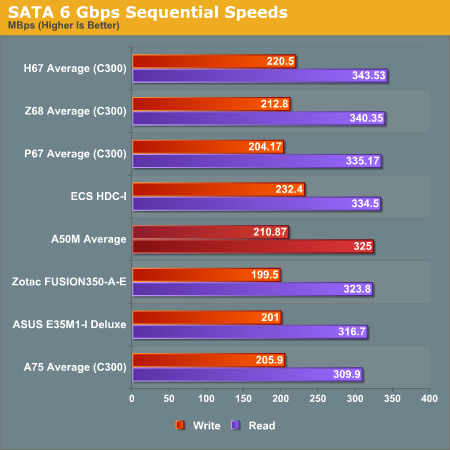Fusion E-350 Review: ASUS E35M1-I Deluxe, ECS HDC-I and Zotac FUSION350-A-E
by Ian Cutress on July 14, 2011 11:00 AM ESTLAN Speed Test
LAN Speed Test is a freeware program designed for testing the network connection between two PCs on a home network. The speed of the transfer is limited by the lowest common denominator on the network, so if you have gigabit Ethernet capable computers but a 100 Mbit capable router, you are limited to 100 Mbit transfer. Note that this is really a formality – if a network port is rated at 1 Gbps, then chances are that it will hit at least 90+% of this value. The main test here is CPU usage, and how much is offloaded by the controller. For this test, we use LAN Speed Test to transfer a 1000 MB file across a home network with a 100 Mbps lowest common speed to the same machine each time, in a read/write scenario. CPU usage is taken as a visual max/average from task manager.

The Fusion boards don't have anything out of the ordinary in the LAN Speed test.

Due to the E-350 CPU in the Fusion boards, transferring data across the network is actually a CPU intensive task, with most boards having a substantial CPU usage. The Zotac has the lowest average CPU usage, but the ASUS has the lowest peak. The ECS board performs badly here, though.
USB Speed
For this benchmark, we run CrystalDiskMark to determine the ideal sequential read and write speeds for the USB port using our 64GB Patriot SuperSpeed USB 3.0 drive. Then we transfer a set size of files from the SSD to the USB drive, and monitor the time taken to transfer. The files transferred are a 1.52 GB set of 2867 files across 320 folders – 95% of these files are small typical website files, and the rest (90% of the size) are HD videos.



Across the USB tests, the Zotac underperforms by quite a considerable margin. I redid the tests, and then got in touch with Zotac regarding this issue. I was given a new BIOS, but this did not improve the results. The ECS board has the best USB performance out of the three A50M boards.
SATA Testing
We also use CrystalDiskMark for SATA port testing. The operating system is installed on the Micron RealSSD C300, which is rated at 355 MB/s read and 215 MB/s write, and the sequential test is run at the 5 x 1000 MB level. This test probes the efficiency of the data delivery system between the chipset and the drive, or in the case of additional SATA ports provided by a third party controller, the efficiency between the controller, the chipset and the drive.

Using the Micron C300, the ECS board outperforms the other two in sequential writes and reads.
DPC Latency
Deferred Procedure Call latency is a way in which Windows handles interrupt servicing. In order to wait for a processor to acknowledge the request, the system will queue all interrupt requests by priority. Critical interrupts will be handled as soon as possible, whereas lesser priority requests, such as audio, will be further down the line. So if the audio device requires data, it will have to wait until the request is processed before the buffer is filled. If the device drivers of higher priority components in a system are poorly implemented, this can cause delays in request scheduling and process time, resulting in an empty audio buffer – this leads to characteristic audible pauses, pops and clicks. Having a bigger buffer and correctly implemented system drivers obviously helps in this regard. The DPC latency checker measures how much time is processing DPCs from driver invocation – the lower the value will result in better audio transfer at smaller buffer sizes. Results are measured in microseconds and taken as the peak latency while cycling through a series of short HD videos - under 500 microseconds usually gets the green light, but the lower the better.

Due to the E-350 CPU, the DPC Latency results of these boards seem a lot worse than the Cougar Point boards we've tested this year. In reality, not many of us will notice this difference.
*A small note about the Zotac board - every thirty seconds or so, a DPC spike is observed around 6000 microseconds. This could seriously be an issue if audio is important to the users of this board - after retesting the board and contacting Zotac, they have not pinpointed the issue yet, but as I understand it, are working on a fix.










67 Comments
View All Comments
triclops41 - Thursday, July 14, 2011 - link
I think Starcraft 2 benchmarks should be included. It is a popular game that can run well on mid and lower end systems.I know it can almost run at lowest settings with the E-350 at stock. But I would really like to know how well SC2 runs when the E-350 is overclocked to 2.1Ghz, considering it was CPU limited before.
Phynaz - Thursday, July 14, 2011 - link
Not single test doing video decode and display = fail.Finally - Thursday, July 14, 2011 - link
...you are taking a Bobcat APU (that's made for netbooks, HTPC and other low power usage devices) and test it on ground of performance by pairing it with a 1000W power supply. (Ian was clever enough not to mention his batshit crazy choice by simply stating "Silverstone 80+ Silver" on the hardware page - a quick check on geizhals.at reveals that there are only 4 power supplies that fall into this category, starting @ 700W and going up to 1000W -> http://geizhals.at/deutschland/?cat=gehps&xf=1...To further add insult to injury he then pairs this netbook APU with a Nvidia 580GTX only to finish this ridiuculousness for good with overclocking the shit out of the CPU...
Come on? What will be tested next? How far the SoC can be thrown when it's raining?
The thing I like best on AnandTech is how your pro-Intel-agitprop is actually brought to words: "Hudson-M1 - why would I want it?" - Imagine this same question being asked when Intel's Atom platform is the topic of the day... mark it well, because that will be the moment hell freezes over...
AnandThenMan - Thursday, July 14, 2011 - link
You're wasting your time. AMD will never get a fair shake on this site, not going to happen. Every notice how there is never a situation where a "mistake" or other choice accidentally gave AMD an unfair advantage? Why is that? Because these choices are on purpose, and are carefully selected to minimize the AMD product as much as possible, while still trying to maintain the appearance of impartiality.This site is a shill of Intel, and the only reason people don't believe that is because it's a hard thing to accept. But the evidence is overwhelming. At one time, there was an entire section of this website dedicated to only Intel, anyone else remember that?
Broheim - Friday, July 15, 2011 - link
if the reviews bother you that much, then why do you come back? is your life really that empty?medi01 - Sunday, July 17, 2011 - link
Somebody has to compensate for shit in articles at least in comments.Broheim - Sunday, July 17, 2011 - link
if "somebody" is dissatisfied, then "somebody" can go make their own hardware review site and review stuff like "somebody" wants to...in the meantime, "somebody" doesn't have to "compensate for shit".
IanCutress - Thursday, July 14, 2011 - link
As I've mentioned, the PSU issue is purely due to what I have available for testing. The GTX580 test, also as I've mentioned, was to provide a plausible maximum ceiling in those tests, and to explore the CPU power with the PCIe x4 against the iGPU. Regarding overclocking - there are people who will overclock everything and anything, regardless of what it's used for. In my mind, it's a valid test - if the platform has headroom with no negative consequences, that's something to look out for, and which to a certain extent the ECS board provided.I'm neither pro-Intel or pro-AMD. I review what I feel is right for the time and situation, and what circumstances allow. We have a series of 9-series boards to look at in the near future, but so far this year all the releases for me to focus on have been Intel based, especially in the motherboard segment. The comment regarding 'why would I want it' was the exact speculative comment I made when the boards came through my door. It's what I ask every board that passes through my hands - if a reviewer didn't ask this, there would be no point him or her reviewing it.
I'm more than open to suggestions by email if there are other tests you think should be added. If there is time and an apt reason to run them (and everyone will be able to interpret the results), I will take a look - the development of testing is always fluid.
Ian
AnandThenMan - Thursday, July 14, 2011 - link
In the interest of full disclosure and proper review procedures, please correct the chart to indicate the make/model/wattage of the power supply, instead of simply "Silverstone 80 PLUS Silver".andymcca - Friday, July 15, 2011 - link
^^ This.And honestly, it should be noted clearly, in plain sight, that power consumption figures are totally meaningless at <5% PSU load.
It's fine that this is the only PSU you have on hand, but (lacking DC power figures, which obviously require special equipment) a low power PSU, preferably a PicoPSU (with a decent brick) or equivalent, is the only reasonable choice here for power testing. Under-loading a PSU can give very misleading results, which deserve a footnote.